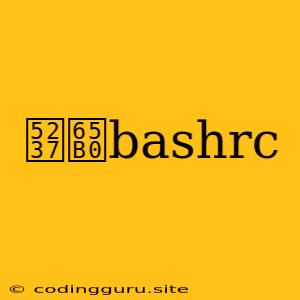What is .bashrc and Why Should You Refresh It?
Have you ever found yourself in a situation where newly installed commands or environment variables don't seem to be working? This might be because your .bashrc file isn't up-to-date.
The .bashrc file is a crucial part of the Bash shell environment in Linux and macOS. It holds custom settings, aliases, environment variables, and commands that are automatically executed whenever you open a new terminal session. This makes it a central hub for configuring your shell experience.
So, What Does "刷新bashrc" Mean?
"刷新bashrc" is the Chinese translation for "refresh bashrc." Essentially, it means you need to update your .bashrc file to ensure it reflects any recent changes you've made.
How to Refresh Your .bashrc File
Here's how you can "refresh" your .bashrc file:
- Open your .bashrc file: You can use any text editor you prefer:
ornano ~/.bashrcvim ~/.bashrc - Make your desired changes: Add or modify your aliases, environment variables, or other settings as needed.
- Save the changes: Use the appropriate save command for your chosen editor (e.g., Ctrl+X followed by Y and Enter in nano, or :wq in vim).
- Source the .bashrc file: This step is crucial to make the changes immediately effective in your current terminal session:
source ~/.bashrc
Alternatively, you can achieve the same result by closing and reopening your terminal.
When to Refresh Your .bashrc
Here are some scenarios where refreshing your .bashrc is essential:
- After installing new software: New software may create new commands or require environment variables to be set.
- Changing your PATH: Your PATH environment variable dictates where your system searches for executable files. Any changes to this variable should be followed by a .bashrc refresh.
- Modifying aliases: When you create or modify aliases, you need to refresh .bashrc for them to take effect.
- Setting environment variables: Setting new environment variables requires you to refresh .bashrc for them to be accessible in your shell.
Example: Adding a New Alias
Let's say you want to create an alias called "lsl" that lists all files in long format, including hidden files.
- Open your .bashrc file:
nano ~/.bashrc - Add the following line to the end of the file:
alias lsl='ls -la' - Save the changes and then source the file:
source ~/.bashrc - Now, you can use the "lsl" command in your terminal to list files with the long format and hidden files.
Troubleshooting Tips
If you're facing issues with your .bashrc file, consider the following:
- Make sure your file is properly formatted: Bash syntax can be tricky. Double-check your commands, aliases, and variable assignments for typos or incorrect syntax.
- Avoid circular dependencies: Avoid creating aliases or commands that depend on each other.
- Test your changes carefully: Before making drastic changes, test them in a separate terminal session to ensure they work as intended.
Conclusion
Understanding the importance of refreshing your .bashrc file is essential for customizing your Bash environment effectively. Remember to "刷新bashrc" after making any changes to ensure that your settings are applied correctly. By following these steps and tips, you can maintain a smooth and efficient workflow in your Linux or macOS terminal.
